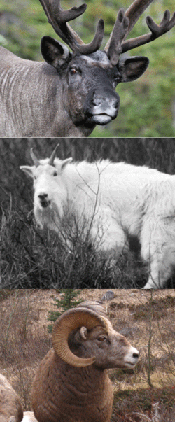
Wildlife flight guidelines
Jasper National Park

Jasper National Park is home to caribou, bighorn sheep and mountain goats, all of which occupy treeless, alpine terrain and are known to flee from low flying aircraft. In the course of normal park operations, flights often occur over alpine areas and can disturb wildlife. These wildlife flight guidelines are intended to help park staff and pilots alleviate some of this disturbance.
Caribou are listed as Endangered under COSEWIC, and are protected by the Species at Risk Act. In Jasper they live mostly in open alpine meadows, or the upper subalpine forest. On hot summer days, caribou need snow patches to avoid overheating and biting insects. Because they are prone to disturbance from aircraft, low overflights can chase caribou from snow banks, resulting in significant stress. Caribou are also prone to disturbance during calving (spring) and the rut (late fall).
Mountain goats live mostly in or near steep, rocky terrain that they use to escape predators. Mountain goats are very sensitive to low aircraft overflight, and will flee from helicopters. When goats run from aircraft they can lose their footing and fall to their deaths.
Bighorn sheep prefer steep sided gravel ridges, and escape predators mostly by running quickly in steep terrain (rather than scaling sheer cliffs, like mountain goats). Although sheep are less of a concern, relative to goats and caribou, their method of escape (running long distances) can lead to energy over-expenditure.
Wildlife flight guideline (628 KB)
Wildlife flight guidelines
Stay high
Fly more than 500m above ground to avoid disturbing wildlife. If you must land in wildlife habitat, descend from and ascend to 500m above ground as quickly as you can.
Stay over trees
The sound of aircraft is muffled when flying over treed areas. Fly over the middle of valleys if possible.
Stay over rocks and ice
If you must fly over treeless areas, then it is better to fly over rock and ice, which is least likely to have wildlife. While it is easy to identify caribou habitat (alpine meadows) or sheep habitat (gravelled or grassy ridges), care must be taken to avoid goat habitat, which can look rocky.
Plan flights for days < 20°C
It is important not to stress animals during hot periods, especially caribou. Plan flights for days with expected temperatures of less than 20°C. If flying cannot be avoided on a hot day, conduct flights in the morning before the temperature reaches 20°C.
Cross wildlife areas at right angles
If you must cross treeless wildlife habitat, do it at right angles: rather than fly along a cliff line (goat habitat) or an alpine meadow (caribou habitat), cross it at right angles at its narrowest point and fly along some habitat that is not likely to be goat escape terrain. Be aware when flying over a cliff drop-off, goats could be scared off the cliff.
Avoid the caribou rut and calving periods
Caribou are prone to disturbance during the rut (late Sept. to early Nov.), when they are usually above treeline, and during calving (late May and early June), when females are especially skittish.
- Date modified :